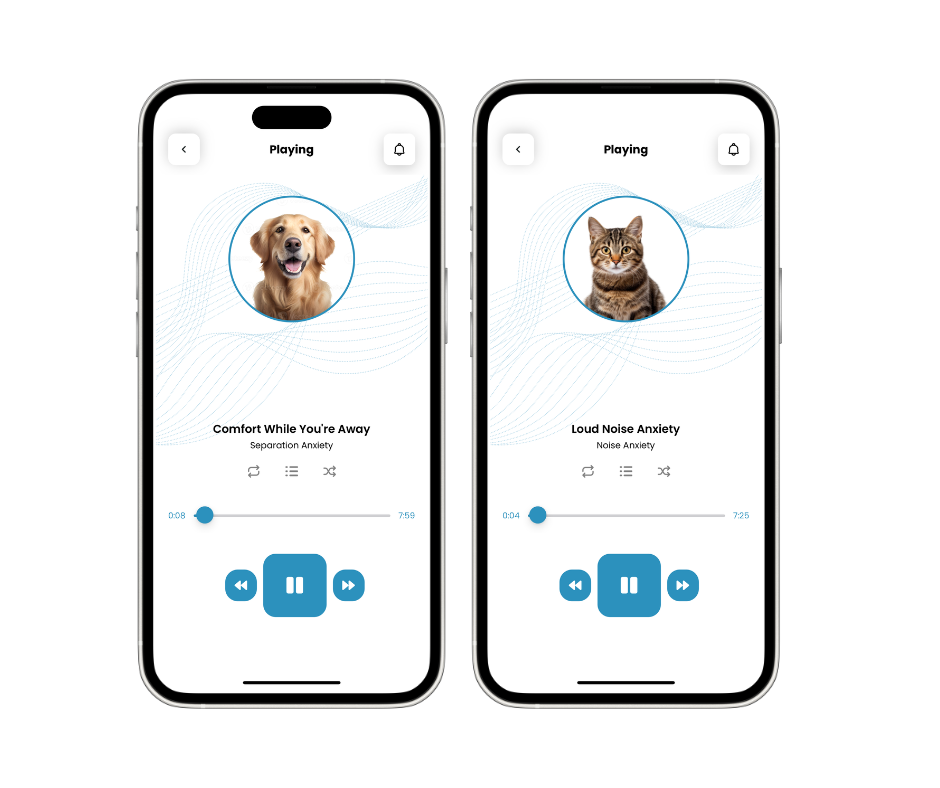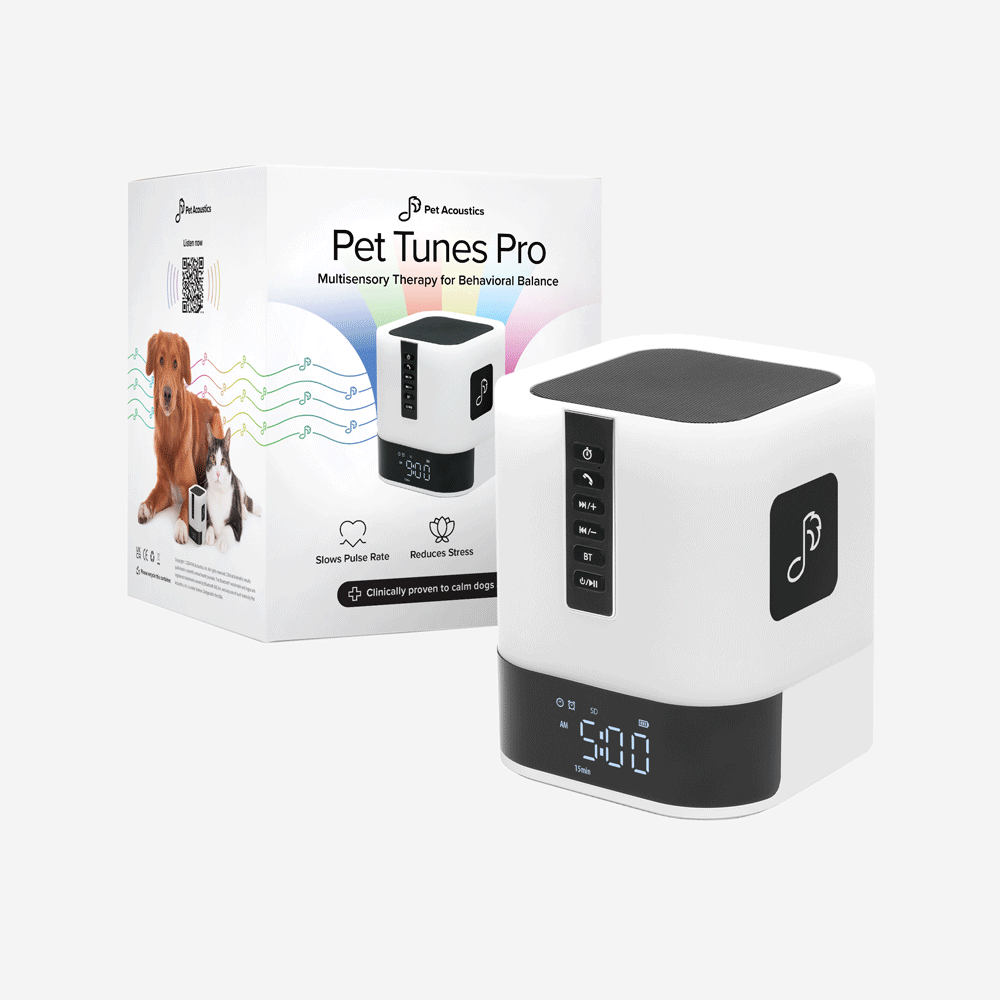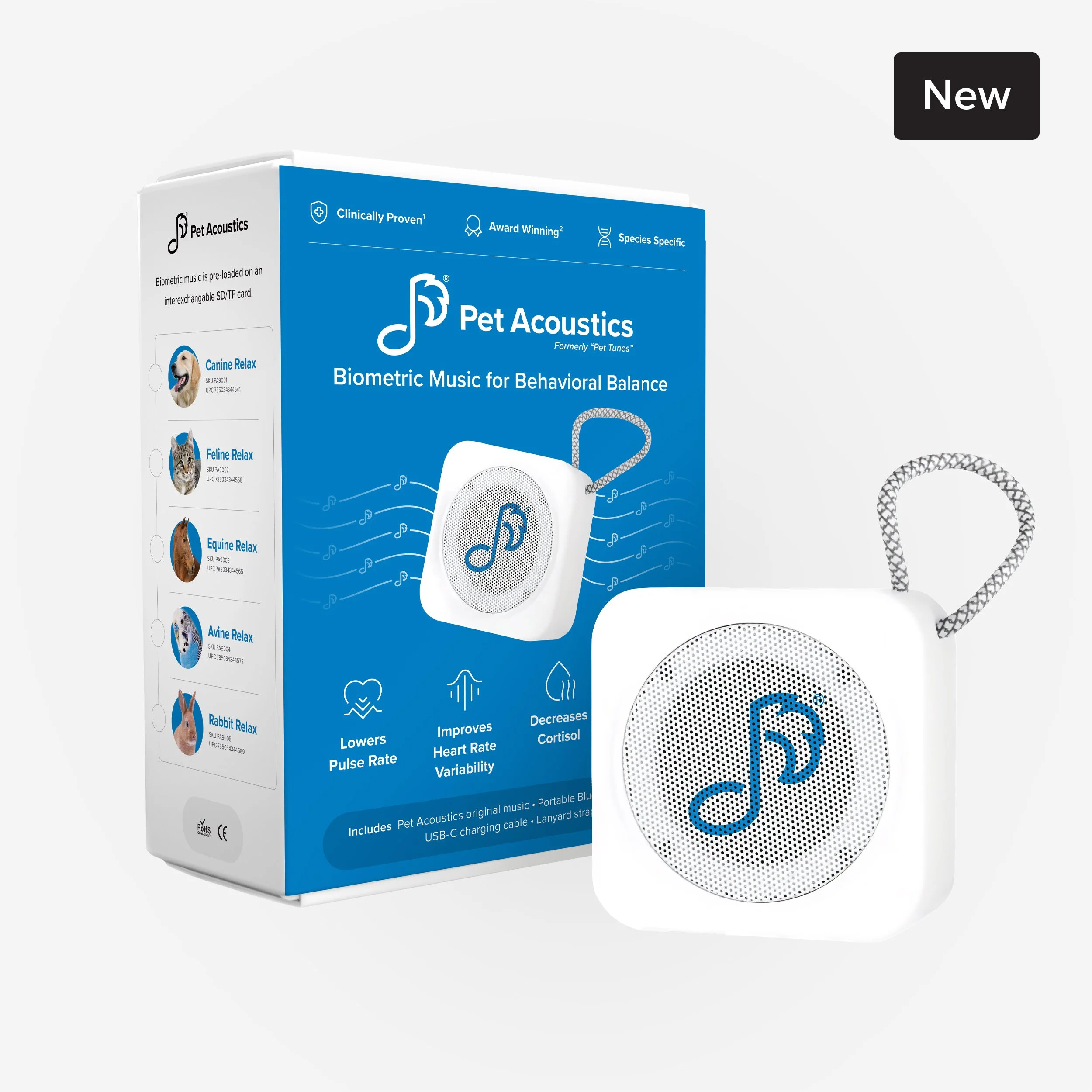Clinical Study Proves Benefits of Feline-Specific Music Through Biometric Data
Printed in International Animal Health Journal (volume 8, issue 2), published in 2021.
Feline behavioural stress is triggered by their acute sensitivity to sounds in the environment. Cats can hear from 40Hz to 85,000 Hz, which is more than three times higher than human hearing, at 20Hz-20,000Hz. To modify behavioural stress in cats, Janet Marlow, Founder of Pet Acoustics innovated science-based music designed for feline acute hearing.
The benefits of this calming music has been repeatable and observable since its use for cats starting in 1997. To further understand the calming effects of this music, a study was initiated to analyse the biometrics of cats while listening to the music. The three-month clinical study monitored nine adult cats measuring their pulse rates, HRV, and activity levels determining the effects of the music. Each cat's vital signs and behaviour patterns were continuously collected in real time wearing a PetPace smart collar. By having a deeper understanding of how feline-specific music diminishes stress in cats on a biometric level can further define its use for feline welfare.
Purpose of Study
The clinical study began in October of 2020 with the purpose of documenting the biometric effects of feline-specific calming music. Two cat breeders volunteered their multiple cat homes in Southern Australia for the study. The nine adult cats monitored were different breeds, which included Abyssinian, American Shorthair Black Silver Classic Tabby, Domestic mixed, Russian Blue and Selkirk Rex Shorthair. Their ages ranged from two years to twelve years.
Each cat’s vital signs of their pulse, Heart Rate Variability (HRV) and activity were recorded using a PetPace smart collar for cats.
The purpose of this study is to support the hypothesis that Pet Acoustics feline calming music induces a physiological and behavioural calmer state in cats. By measuring the pulse, HRV and activity scores, we can show the physiological and behavioural responses to the music. The nine adult cats were male and female, neutered and not neutered, different breeds and different ages.
Monitoring feline vitals (pulse, HRV and activity) while playing Pet Acoustics species-specific music.
Data of Each Cat Tested
Biometric Measures Tested
Pulse
Pulse, or heart rate, is the measurement of the number of times a pet’s heart beats per minute. Heart rate is one of the most important vital signs caregivers can measure for your pet. When the heart rate is measured peripherally by palpating or sensing the pulse in a limb, it is called pulse. The job of the heart is to pump blood throughout the body, supplying oxygen to the cells. Your pet’s heart rate is controlled by a sophisticated mechanism that takes into account the oxygen demand from the cells and makes sure the heart is able to provide it. For example, when a dog runs, its muscles work hard and consume a lot of oxygen. Therefore, the heart must work faster to supply the demand. Fear is another condition that is associated with increased heart rate in pets. When a pet (or a human) is afraid, the body gets ready for a fight- or-flight situation and prepares for the anticipated increase in demand for oxygen.
Heart Rate Variability (HRV)
Heart rate variability (HRV) is a statistical analysis of the small variations in time intervals between heartbeats. The variations are innate and normal physiological phenomena. Studies have shown that changes in HRV are associated with a wide range of diseases as well as pain, stress, and obesity. HRV is recognised as a marker for autonomic nervous system activity. The autonomic (parasympathetic and sympathetic) nervous systems as well as hormonal factors provide the main input to the heart’s pacemaker, and the beat-to-beat interval variability is a reflection of the balance between these two. High HRV indicates a good fitness level and a healthy heart and nervous system. Low HRV is associated with stress, pain, heart disease and other pathologies.
Activity Score
Activity score is a calculated value that provides a quantitative representation of a pet's activity during the selected time range. It is based on summarising all the separate activity readings and producing a total value for the pet's overall activity. What is known is that monitoring and analysing activity patterns and levels can provide valuable medical insights. For example, a decline in activity levels may indicate the development of a disease-causing pain or weakness. Activity is also affected by stress levels, but this effect is more complex. Some cats respond to stress by being restless and vocal, while others respond by freezing and hiding. The study evaluated each cat’s activity levels.
Materials and Methods
There were two catalysts used for the study: the PetPace smart collar and the Pet Acoustics feline calming music. Each of the nine adult cats wore the PetPace collar over a four-day period. Biometric data was collected by an array of sensors in the collar for twelve to twenty-four hours without the music playing. After this time period, the Pet Acoustics feline calming music was turned on for twelve to twenty-four hours in the area of the collared cat. The music was broadcast from a portable Pet Acoustics Pet Tunes speaker which is pre-loaded with the music on a micro SD card. The feline-specific music played continuously until it was turned off. During the listening session, the pulse rate, HRV and activity data was collected. The data occurred in real time and could be seen on a cloud- based analysis engine program.
The music is specific to the comfort hearing of cats which is within 60 to 80dB. Additionally, the music is modified by frequency content to stay within the frequency levels that do not trigger hypervigilant response. This proprietary process was innovated by Janet Marlow in 1997.
After the first cat’s testing was completed, the collar was removed and placed on the next cat. The same method was done with each of the other eight cats collecting the biometric data every fifteen minutes during the four-day period. Each cat was tested with half of the session with no music playing and then with the music playing.
When the music wasn’t playing, each cat heard and responded to the natural sounds of home life. During the three- month period, however, there were sounds of workmen and construction in the home and several intense thunderstorms. One cat travelled in a car in a crate. Within the two homes of the nine cats tested, there were multiple cats and a dog.
Music in the feline study was broadcast from a portable Pet Acoustics Pet Tunes Feline speaker.
Results
The pulse rate and the activity were lower as well as the HRV being higher when the cats were exposed to the calming music.
Pulse
The pulse rate was lower, and the distribution of results was narrower. The overall median pulse rate was 3.3% lower during times when the cats were exposed to the music (148) compared to times when the cats were not exposed to the music (153). Four of nine cats had a lower median pulse rate during music time. Moreover, the distribution of pulse readings during the music time was lower (range 101-216, delta 115) compared to the non-music times (range 89-232, delta 143).
Each point on the graph indicates a specific pulse measurement made by the collar. By moving the cursor over the point, one can see the actual reading and the time it was made. The line is a simple moving average of the pulse readings.
If the pulse rate is too high (tachycardia) or too slow (bradycardia) for the dog or cat’s activity level, an alert will be generated to have your pet examined by a veterinarian.
HRV
HRV is higher with music and the distribution of results is narrower. In this study, the overall median HRV was 4.6% higher during times when the cats were exposed to the music (9.48) compared to times when the cats were not exposed to the music (9.06). All cats had a higher median HRV during music time. The distribution of HRV readings during music time was lower (range 8.1-10.36, delta 2.26) compared to the no-music times (range 6.7-10.47, delta 3.77).
Each point on the graph is a statistical analysis of the small variations in time intervals between heartbeats. The variations are innate and normal physiological phenomena. Studies have shown that changes in HRV are associated with a wide range of diseases as well as pain, stress and obesity. High HRV indicates good fitness level and healthy heart and nervous system. Low HRV is associated with stress, pain, heart disease and other pathologies. There is no published reference range for HRV-VVTI. Based on preliminary analysis, we estimate that the following ranges apply for dogs:
>11.5 Normal
11.0-11.5 Suspicious
<11.0 Likely to indicate a health problem
The normal range for cats is not yet completely established. Values >9.5 are likely a deviation (decrease) from the typical values indicating a possible health problem or stress.
Activity
Activity score is a calculated value that provides a quantitative representation of a pet's activity during the selected time range. It is based on summarising all the separate activity readings and producing a total value for the pet's overall activity. The overall median activity score was 8.2% lower during times when the cats were exposed to the music (46.9) compared to times when the cats were not exposed to the music (51.1). All nine cats had a lower activity score during music time compared to no-music times.
This chart divides the pet’s activity intensity into four levels – resting, low, medium and high activity. Low activity helps identify pain from orthopedic problems, like joint disease, or general health issues causing fatigue and lethargy. High activity may be associated with restlessness, agitation, alertness and discomfort. Monitoring activity is useful when pets are recovering from trauma, surgery or disease, to ensure that they get the rest they need and gradually resume normal activity patterns.
Conclusions
The Pet Acoustics music that was tested in this study caused physiological and behavioural changes indicating a calmer state for cats. The activity levels of all the cats tested was lower. The overall pulse rate was lower and the distribution of the results was narrower. The HRV for all cats was higher with the music and the distribution of the results was narrower.
All these findings supported the hypothesis of a calming effect as a result of the cats listening to the music. The most significant finding was the HRV, which showed a considerable elevation from baseline, even more than what we see with the pulse. HRV was lower when the sympathetic tone (fight- or-flight mode) was higher, and vice versa. Therefore, a calm animal should have a higher HRV.
Aggregate Data
Benefits for Canine Welfare
The results of the Pet Acoustics study proved that feline- specific music modifies behaviours in cats. The stress scores were significantly lower in cats listening to the music as compared with no music. There were no significant differences when comparing the sex, age or breed of the cats, whether they were neutered or not and whether they were outdoor or indoor cats, all responded positively to the music.
For veterinarians, when listening to the Pet Acoustics feline calming music there is a reduction in stress, which allows the team to conduct better physical examinations and take more accurate vitals. Broadcasting this music in the waiting rooms of veterinary clinics helps to ease the anxiety of waiting cats.
Applications and Benefits
Calms behaviours in cat shelters
Relieves muscle tension during grooming sessions
Masks agitating sounds of thunderstorm and firework
Events
Calms behaviour for breeding and birthing
Reduces stress introducing a newly adopted cat
Ideal for stress management for post-surgery healing
Diminishes crate travel anxiety
Lessens nocturnal activity
Pet Acoustics music helping to calm an anxious cat patient at the Litchfield Veterinary Clinic.
Contributors
Janet Marlow
Founder and Sound Behaviorist, Pet Acoustics












